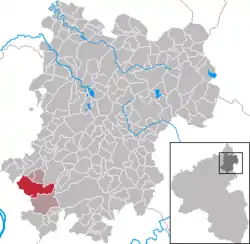Höhr-Grenzhausen
Höhr-Grenzhausen (German pronunciation: [ˌhøːɐ̯ɡʁɛnt͡sˈhaʊ̯zn̩] ⓘ) is a town in the Westerwaldkreis in Rhineland-Palatinate, Germany. It is a centre for the ceramic industry in the Kannenbäckerland with a professional college for ceramics, another for ceramic form, and many others, hence the nickname Kannenbäckerstadt (roughly, “Jug Baking Town”).
Höhr-Grenzhausen | |
|---|---|
 Coat of arms | |
Location of Höhr-Grenzhausen within Westerwaldkreis district  | |
 Höhr-Grenzhausen  Höhr-Grenzhausen | |
| Coordinates: 50°26′06″N 7°40′16″E | |
| Country | Germany |
| State | Rhineland-Palatinate |
| District | Westerwaldkreis |
| Municipal assoc. | Höhr-Grenzhausen |
| Government | |
| • Mayor (2019–24) | Michael Thiesen[1] |
| Area | |
| • Total | 15.87 km2 (6.13 sq mi) |
| Elevation | 250 m (820 ft) |
| Population (2021-12-31)[2] | |
| • Total | 9,368 |
| • Density | 590/km2 (1,500/sq mi) |
| Time zone | UTC+01:00 (CET) |
| • Summer (DST) | UTC+02:00 (CEST) |
| Postal codes | 56203 |
| Dialling codes | 02624 |
| Vehicle registration | WW |
| Website | www |
Together with the communities of Hillscheid, Hilgert and Kammerforst it has formed the Verbandsgemeinde of Höhr-Grenzhausen – a kind of collective municipality – since 1971.
Politics
Town partnerships
Höhr-Grenzhausen maintains partnerships with these towns:
 Laigueglia, Riviera, Italy (since 1972)
Laigueglia, Riviera, Italy (since 1972) Semur-en-Auxois, Burgundy, France (since 1987)
Semur-en-Auxois, Burgundy, France (since 1987)
Culture and sightseeing
Museums
In the town are found the Westerwald Ceramics Museum (Keramikmuseum Westerwald) and a museum of the town's history.
Buildings
- Evangelical church
- Grenzau Castle
- Limes Germanicus, a UNESCO World Heritage site, in particular the Ferbach fort
Sport
Höhr-Grenzhausen's outlying centre of Grenzau is home to the TTC Zugbrücke Grenzau, a table tennis club involved in Bundesliga play. Likewise, the Rhineland-Palatinate table tennis Olympic base is found here.
Economy and infrastructure
Economy
RASTAL GmbH & Co. KG, which is a business established in Höhr-Grenzhausen, is one of Europe's biggest manufacturers of decorated drinking vessels, especially beer glasses.

Since the 1500s, the area has been one of the most productive salt-glazed pottery centers in Europe. In the mid 16th century, potters from Raeren in Belgium migrated into the Westerwald, bringing with them some of their moulds. This type of pottery was taken to the New World and was found in the early Chesapeake settlements.
Gray Westerwald pottery is easily recognized with its curling blue flourishes, often in simple floral and leaf patterns. It is still molded by hand and fired in wood-burning kilns throughout the area. The town-wall is decorated all along its full length with huge ceramic pots made by various potters of the area. The International Ceramics Market & Museum Festival is held the first weekend in June, featuring around 150 exhibitors from all over Europe, including Spain, France, Belgium, The Netherlands, Poland and Hungary.[3][4][5]
Notable people
- Karlheinz Zöller (1928–2005), musician
References
- Direktwahlen 2019, Westerwaldkreis, Landeswahlleiter Rheinland-Pfalz, accessed 9 August 2021.
- "Bevölkerungsstand 2021, Kreise, Gemeinden, Verbandsgemeinden" (in German). Statistisches Landesamt Rheinland-Pfalz. 2022.
- Kolbert, Elizabeth (1984-04-22). "The Salty Secret of German Pottery". New York Times.
- "European Cities Join Forces to Attract Ceramics Enthusiasts". New York Times. 2014-10-23.
- Smith, Beth (1991-01-03). "A Westerwald History". Stein Collectors International.
Further reading
- Fries, Heribert (1993), Kurrimurri : Erinnerungen an die Kannenbäcker in Höhr-Grenzhausen (in German), Höhr-Grenzhausen: Stadt Höhr-Grenzhausen, ISBN 3-9801311-3-0